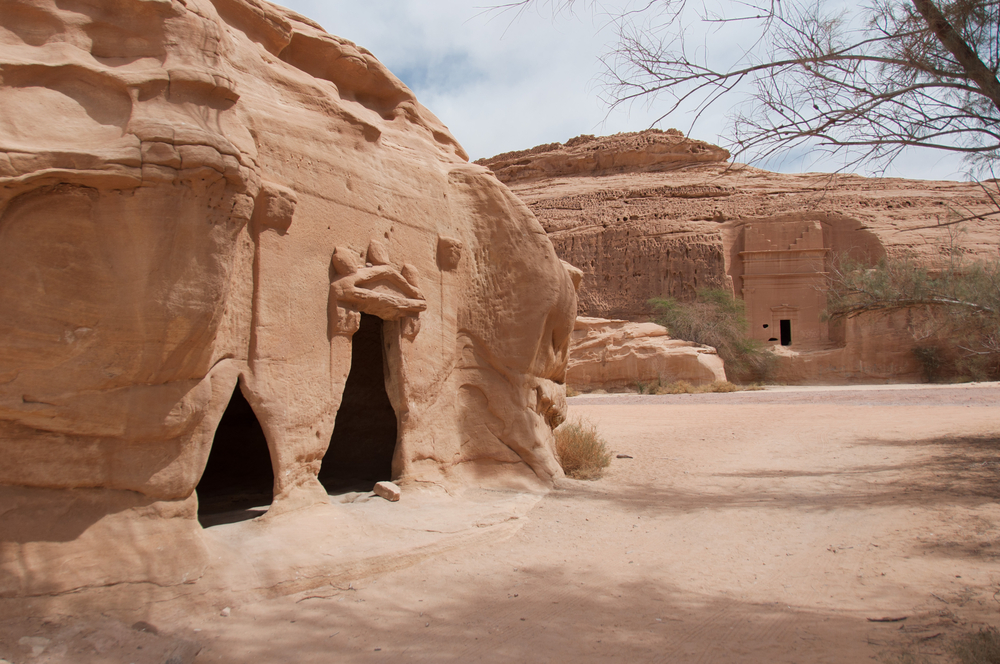Tourism officials see growing Saudi interest in heritage and history
Photo: SAUDI ARABIA: Nabatean tombs in Madain Saleh archeological site / Hugo Brizard / YouGoPhoto
Following decades of government neglect, Saudi Arabia has turned dozens of historical sites throughout the kingdom into tourism destinations. It’s been a boon for tour operators, but equally important is that a new generation of Saudis have taken a keen interest in their cultural and religious history.
The kingdom boasts more than 100 heritage sites. The most popular are perhaps the Naseef House in Old Jeddah, built in 1872, and Al-Ula, a town near the ancient ruins of Mada’in Saleh that was once at the crossroads of an important trade route between Medina and Tabuk.
But there are also more obscure sites largely unknown to tourists, such as the Eieiraif Fortress atop a hill in Hail and the Divan Heritage Souk in southeast Qassim province.
ARCHAELOGICAL SITES
Since 2011, European and North American research teams have scoured the Arabian Peninsula discovering relics from the age of the dinosaurs through the Bronze Age.
Off-limits to non-Muslims are several Islamic archeological sites, among them the Joatha Mosque, about 20 kilometers northeast of Hofuf; the Aldoor archaeological dig, an ancient burial mound, in southeast Al-Ahsa, and the ancient village of Al-Garah, dating to the Abbasid and Umayyad dynasties in northern Saudi Arabia.
“Tourists can easily visit any heritage site,” said Erdogan Ekiz, a professor at King Abdulaziz University’s Tourism Institute. “One just needs identification, and permission is not needed. But the Islamic sites are only for Muslim tourists. Those sites are considered much like Medina and Mecca as holy places.”
INCREASING INTEREST
Ekiz said that interest has increased significantly in recent years as more hajj and umrah pilgrims are visiting religious sites as a way to learn more about the Prophet Mohammed.
Another sign that the government is committed to its history is a new course offered by King Abdulaziz University on national heritage. The curriculum is expected to be offered to students for the fall semester of 2017, said Ekiz.
Fahad Al-Safh, operator of the halal travel company Explorer Tours, said that many heritage sites had been destroyed before tourism authorities fenced off areas starting in 2000 in order to begin the slow process of starting archeological digs.
“Most of the tourists who visit these [non-Islamic] sites are Westerners … who are not Muslim,” said Al-Safh, who noted the majority of his clients are non-Muslims and Western expatriates living in Saudi Arabia.
But he notes that Saudis today are much more knowledgeable of their heritage than the previous generation. “The new generation is interested in seeing something related to their history,” Al-Safh said.
Meteb Al-Mahmoud, who operates Amazing Tours, said government attention to preserving heritage sites has improved dramatically.
“You see improvements in Mada’in Saleh and in Hail in the north, but less attention is paid in the south,” said Al-Mahmoud said. “[The government] bases its improvements on the importance of the sites, and there are less visitors and less interest in the south so things have been slow down there.”
The Commission for Tourism and National Heritage has never made it a secret that its first priority is to boost domestic tourism, followed by attracting Muslim visitors from the GCC. But down the road, the commission is eyeing the international non-Muslim market, especially since the government is eager to diversify its revenue sources.
WORLD HERITAGE SITES
Today the archeological site Mada’in Saleh, Old Jeddah, the rock art venue in Hail and Al-Diriyah, the original home of the Saudi royal family, are registered with UNESCO as World Heritage Sites. The Commission for Tourism and National Heritage is preparing other sites to attract non-Muslim visitors interested in Saudi Arabia’s cultural history.
For now, however, the emphasis will remain on Muslim tourists as the commission develops plans to research and preserve more Islamic history sites with a focus on the era of early Muslim caliphs.
The first step is identifying Islamic sites. The commission will then promote those venues to Saudi students, in particular, to “link” them to their “Islamic history based on the tangible and credible historical information,” according to the commission.
“The government is paying attention to its national heritage,” Ekiz said.
© SalaamGateway.com 2016

Rob L. Wagner